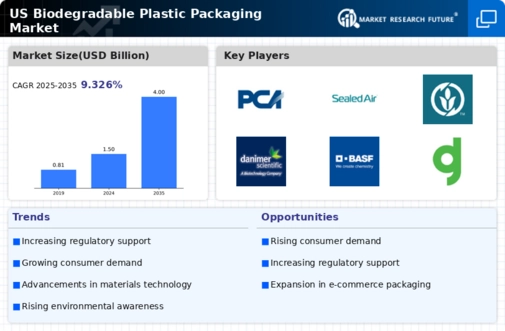Increasing Environmental Awareness
The growing consciousness regarding environmental issues among consumers is a pivotal driver for the biodegradable plastic-packaging market. As individuals become more informed about the detrimental effects of traditional plastics on ecosystems, they are increasingly opting for sustainable alternatives. This shift in consumer behavior is reflected in market data, indicating that approximately 70% of consumers in the US express a preference for eco-friendly packaging solutions. Consequently, businesses are compelled to adapt their packaging strategies to align with this demand, thereby fostering growth in the biodegradable plastic-packaging market. Companies that prioritize sustainability not only enhance their brand image but also tap into a lucrative segment of environmentally conscious consumers, which is likely to expand further in the coming years.
Consumer Preference for Convenience
The trend towards convenience in consumer lifestyles is significantly influencing the biodegradable plastic-packaging market. As consumers seek packaging solutions that are not only sustainable but also user-friendly, the demand for biodegradable options that offer convenience is on the rise. This is particularly evident in sectors such as food and beverage, where packaging needs to be functional while minimizing environmental impact. Market data indicates that around 60% of consumers are willing to pay a premium for packaging that is both biodegradable and convenient. This consumer preference is prompting manufacturers to innovate and develop packaging that meets these dual demands, thereby driving growth in the biodegradable plastic-packaging market. As convenience continues to be a priority for consumers, the market is expected to evolve, with an increasing focus on integrating sustainability into practical packaging solutions.
Corporate Sustainability Initiatives
Many corporations are increasingly adopting sustainability initiatives, which significantly impacts the biodegradable plastic-packaging market. Companies are recognizing the importance of integrating sustainable practices into their operations, not only to enhance their corporate social responsibility but also to meet consumer expectations. This trend is evident as major brands commit to reducing their plastic footprint, with some pledging to use 100% recyclable or compostable packaging by 2025. Such commitments are likely to drive demand for biodegradable packaging solutions, as businesses seek to align their packaging with their sustainability goals. The market is expected to benefit from this corporate shift, with projections indicating a compound annual growth rate (CAGR) of 15% over the next five years, as more companies transition to biodegradable options.
Innovation in Biodegradable Materials
The advancement of innovative biodegradable materials is a crucial driver for the biodegradable plastic-packaging market. Research and development efforts are yielding new materials that offer enhanced performance characteristics, such as improved barrier properties and durability. These innovations are making biodegradable packaging more competitive with traditional plastics, thereby attracting a broader range of industries. For instance, the introduction of polylactic acid (PLA) and polyhydroxyalkanoates (PHA) has expanded the options available for manufacturers. As these materials become more accessible and cost-effective, the market is likely to experience accelerated growth. Current estimates suggest that the biodegradable plastic-packaging market could expand to $6 billion by 2028, driven by these technological advancements and the increasing adoption of biodegradable materials across various sectors.
Legislative Pressure for Sustainable Practices
Legislation aimed at reducing plastic waste is exerting considerable influence on the biodegradable plastic-packaging market. Various states in the US have enacted laws that restrict the use of single-use plastics, thereby creating a favorable environment for biodegradable alternatives. For instance, California's recent ban on certain plastic products has prompted businesses to seek compliant packaging solutions. This regulatory landscape is expected to drive the market's growth, as companies strive to meet legal requirements while appealing to eco-conscious consumers. The financial implications are notable, with the biodegradable plastic-packaging market projected to reach $5 billion by 2027, driven largely by these legislative changes. As regulations tighten, the demand for biodegradable packaging is likely to surge, positioning it as a viable alternative in the packaging industry.






















Leave a Comment